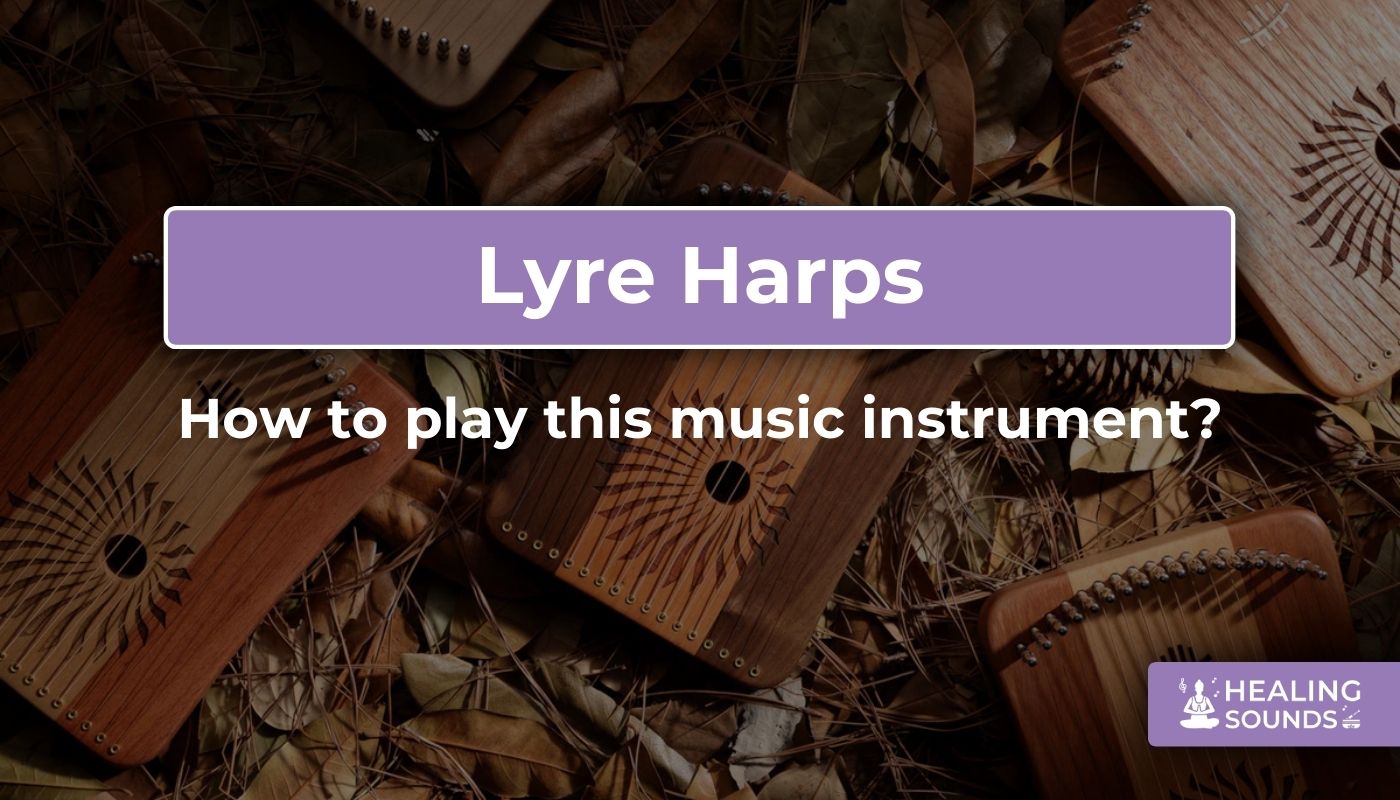La lyre , avec ses racines ancestrales et ses mélodies éthérées, offre une porte d'entrée unique dans le monde de la musique. Souvent associée à des sons apaisants et à des vertus thérapeutiques, apprendre à jouer de la lyre peut être une expérience profondément enrichissante, surtout pour ceux qui recherchent la détente et une initiation douce aux instruments à cordes. Si le charme envoûtant de la musique de la lyre vous attire, ce guide est fait pour vous, débutant curieux souhaitant vous lancer dans ce voyage musical.
Nous explorerons tout, des bases de la structure de la lyre aux étapes pratiques pour jouer vos premières notes. Que vous ayez déjà une expérience musicale ou que vous soyez totalement novice, vous trouverez des conseils clairs pour commencer à jouer de la harpe-lyre en toute confiance et découvrir les bienfaits apaisants de ce magnifique instrument.
Qu'est-ce qu'un instrument lyre ?
Avant de plonger dans le jeu, découvrons l'instrument lui-même. La lyre est un instrument à cordes datant de la Grèce antique, connu pour son cadre en U, ses deux bras, sa traverse et ses cordes reliant la traverse au corps de résonateur. Contrairement aux harpes plus grandes, les lyres traditionnelles sont souvent plus compactes et faciles à transporter.
Les lyres modernes existent en différentes tailles et nombres de cordes, mais elles conservent leurs éléments de conception fondamentaux. Le corps, souvent en bois, fait office de caisse de résonance pour amplifier les vibrations des cordes pincées. Des chevilles d'accord, généralement situées sur la traverse ou le cadre, permettent de régler la hauteur de chaque corde. Comprendre cette structure est la première étape pour apprécier les nuances de la musique de lyre .
Historiquement, la lyre était associée à la narration, à la poésie et aux rituels de guérison. Vous pouvez en apprendre davantage sur ses origines anciennes grâce à des ressources comme la collection du Metropolitan Museum of Art .
Est-il facile de jouer de la lyre ?
De nombreux débutants se demandent si la lyre est difficile à apprendre. Comparée à des instruments comme la guitare ou le violon, la lyre est souvent considérée comme l'un des instruments à cordes les plus accessibles, ce qui en fait un excellent choix pour les débutants en musique.
Son accordage typiquement ouvert (souvent pentatonique) permet de produire des sons harmonieux même en pinçant de manière aléatoire, ce qui est extrêmement encourageant pour les débutants. Si maîtriser des morceaux complexes demande de la pratique, apprendre des mélodies de base et créer des sons apaisants est relativement rapide, ce qui correspond parfaitement aux objectifs de relaxation et de plaisir personnel.
Choisir sa première harpe-lyre (orientation débutant)
Choisir la bonne lyre pour débutant est crucial pour un apprentissage réussi. Les facteurs clés incluent le nombre de cordes, la taille, le poids et les matériaux.
Pour les débutants, une lyre de 10 à 19 cordes est souvent recommandée. Un nombre réduit de cordes simplifie l'apprentissage et permet de se concentrer sur les techniques fondamentales comme la tenue, le pincement et les mélodies de base sans se sentir dépassé. Envisagez un modèle spécialement conçu pour le confort et la facilité de manipulation.

Harpe lyre à 16 cordes pour débutants
56,90 $ 73,90 $
La harpe lyre Zani Mini 16 cordes est parfaite pour les débutants, offrant une facilité de jeu et des sons apaisants pour démarrer votre voyage musical.
Découvrez cette lyre pour débutantsComment tenir une lyre pour les débutants
Une posture et une technique de tenue correctes sont essentielles pour jouer confortablement et produire un son clair. Voici comment tenir une lyre :
- Positionnement : Asseyez-vous confortablement, le dos droit, sur une chaise. Vous pouvez poser la base de la lyre sur vos genoux. Les lyres plus grandes peuvent être placées entre vos genoux ou sur une table.
- Soutien : Utilisez votre bras non dominant (généralement le gauche) pour soutenir la lyre. Votre avant-bras peut délicatement soutenir le côté ou l'arrière du cadre de l'instrument, le maintenant stable sans trop serrer.
- Angle : inclinez légèrement la lyre vers vous afin de pouvoir voir clairement les cordes et les atteindre confortablement avec votre main dominante.
- Détente : Assurez-vous que vos épaules, vos bras et vos poignets sont détendus. Les tensions peuvent gêner votre jeu et engendrer de l'inconfort à long terme.
Expérimentez pour trouver la position la plus naturelle et la plus stable pour vous et votre modèle de lyre spécifique.
Comment jouer de la lyre étape par étape
Prêt à faire de la musique ? Voici un guide étape par étape pour commencer à jouer de la harpe-lyre :
1. Accorder votre lyre
Avant de jouer, votre lyre doit être accordée. La plupart des lyres sont livrées avec une clé d'accordage. Vous pouvez utiliser un accordeur chromatique numérique ou une application d'accordage sur votre smartphone.
Tournez les chevilles d'accordage lentement ; de petits ajustements font toute la différence. Le sens horaire augmente généralement la hauteur, le sens antihoraire la diminue (cela peut varier). Accordez chaque corde sur la note qui lui est attribuée (souvent indiquée dans le manuel de la lyre ou dans des grilles d'accordage courantes comme la pentatonique en do majeur). Un accordage régulier est essentiel pour une belle musique à la lyre .
Pour un guide détaillé, consultez notre article sur l'accordage de votre harpe lyre étape par étape .
2. Techniques de pincement de base
La manière la plus courante de jouer de la lyre est de pincer les cordes avec les doigts.
- Utilisez les coussinets de votre pouce et de votre index (ou d’autres doigts) de votre main dominante.
- Gardez votre poignet détendu et utilisez une pression douce et constante pour pincer chaque corde.
- Expérimentez en pinçant plus près du chevalet (pour un son plus clair) ou plus loin (pour un son plus doux et plus chaud).
- Entraînez-vous à pincer clairement les cordes une par une. Essayez les gammes ascendantes et descendantes.
Certains musiciens utilisent également un plectre, ce qui produit un son différent, souvent plus clair. Essayez les deux méthodes pour trouver celle qui vous convient le mieux.
3. Jouer des mélodies et des accords simples
Une fois à l'aise avec le pincement des notes individuelles, essayez des mélodies simples. De nombreuses chansons folkloriques traditionnelles utilisent des gammes simples, faciles à jouer sur une lyre pentatonique.
Vous pouvez également jouer des accords en pinçant plusieurs cordes simultanément ou en les grattant doucement sur un groupe de cordes. Commencez par des combinaisons de deux notes (dyades) et progressez progressivement vers trois notes ou plus.
- Commencez lentement et concentrez-vous sur la clarté.
- Pratiquez les gammes quotidiennement pour développer la dextérité des doigts.
- Apprenez des chansons simples comme « Mary Had a Little Lamb » ou « Twinkle Twinkle Little Star ».
- Écoutez attentivement les sons que vous produisez.
- Soyez patient et profitez du processus !
Les bienfaits apaisants de la musique de lyre
Au-delà de l’apprentissage d’un instrument, jouer de la lyre offre des bienfaits considérables, notamment pour la relaxation et le bien-être – une raison essentielle pour laquelle de nombreux débutants y sont attirés.
Les sonorités douces et résonnantes de la lyre sont intrinsèquement apaisantes. Pincer les cordes et créer des sons harmonieux peut être une pratique méditative, contribuant à réduire le stress, à apaiser l'esprit et à favoriser un sentiment de paix. S'adonner à la musique de la lyre stimule la créativité et offre une forme d'expression personnelle épanouissante.
Nombreux sont ceux qui constatent qu'intégrer la lyre à leur routine renforce la pleine conscience et offre un moment d'évasion bienvenu face aux pressions quotidiennes. Ce lien entre son et guérison est au cœur de l'expérience Healing Sounds.
Découvrez les harpes lyres adaptées aux débutants

59,90 $
79,90 $
Fabriquée en palissandre, cette lyre à 17 cordes offre un son riche, idéal pour explorer la musique relaxante. En savoir plus ➔
Avec ses 24 cordes, cette lyre offre une gamme plus large pour ceux qui souhaitent perfectionner leur jeu de harpe-lyre . En savoir plus ➔
Entretien de votre instrument lyre
Un entretien approprié préservera la beauté du son de votre lyre pendant de nombreuses années. Essuyez régulièrement les cordes et le corps avec un chiffon doux et sec pour éliminer la poussière et les huiles de vos doigts. Rangez votre lyre dans un étui ou un sac lorsque vous ne l'utilisez pas, afin de la protéger des variations d'humidité et des dommages potentiels.
Vérifiez régulièrement les chevilles d'accordage pour vous assurer qu'elles maintiennent bien la tension. Si des cordes cassent, remplacez-les par des cordes de calibre adapté à votre modèle de lyre. Un entretien régulier garantit que votre lyre reste un plaisir à jouer.
Conclusion
Apprendre à jouer de la lyre est une activité accessible et profondément enrichissante, idéale pour tous ceux qui recherchent la détente, l'expression créative ou une initiation douce à la musique. Du choix de la lyre idéale pour débuter à l'apprentissage de sa prise en main, en passant par l'accordage et le pincement de vos premières mélodies, ce voyage est jalonné de découvertes et de sons apaisants.
N'oubliez pas que la patience et une pratique régulière sont essentielles. Adoptez la nature apaisante de la lyre et savourez l'apprentissage. Healing Sounds vous accompagne dans votre cheminement avec des instruments de qualité conçus pour inspirer et faciliter la guérison par le son. Explorez notre collection et trouvez la lyre idéale pour débuter votre aventure.
Questions fréquemment posées sur la pratique de la lyre
Oui, la lyre est généralement considérée comme l'un des instruments à cordes les plus faciles à apprendre, surtout pour les débutants. Ses systèmes d'accordage courants créent souvent facilement l'harmonie, et les techniques de pincement de base s'apprennent relativement rapidement, ce qui la rend très encourageante pour les nouveaux musiciens en quête de détente musicale.
Posez confortablement la base de la lyre sur vos genoux, en position assise. Utilisez votre avant-bras non dominant (généralement le gauche) pour soutenir délicatement le cadre et le maintenir stable. Inclinez-le légèrement vers vous afin de pouvoir voir et atteindre facilement les cordes avec votre main dominante (celle qui pince). Assurez-vous que vos épaules et vos bras sont détendus.
Pour de nombreux débutants, la lyre est plus facile à apprendre que la guitare. Les lyres ont souvent moins de cordes, un accordage plus simple et ne nécessitent pas de doigtés ni de formes d'accords complexes au départ, contrairement à la guitare. La technique consistant à pincer les cordes à vide pour créer des mélodies est souvent plus gratifiante sur une lyre.
Une lyre de 10 à 19 cordes est souvent idéale pour les débutants. Cette tessiture offre suffisamment de notes pour jouer des mélodies et des accords simples sans être trop complexe. Des instruments comme une harpe lyre à 16 cordes ou un modèle à 17 cordes constituent un excellent point de départ.
1. Choisir et accorder : Choisissez une lyre adaptée aux débutants et accordez-la à l'aide d'un accordeur. 2. Tenir correctement : Placez la lyre confortablement sur vos genoux, en la soutenant doucement. 3. Apprendre à pincer : Entraînez-vous à pincer les cordes individuellement proprement du bout des doigts. 4. Jouer des gammes : Entraînez-vous à jouer des notes ascendantes et descendantes. 5. Essayer des mélodies : Apprenez des chansons simples ou créez vos propres motifs. 6. Pratiquer régulièrement : La constance est la clé de l'amélioration.


